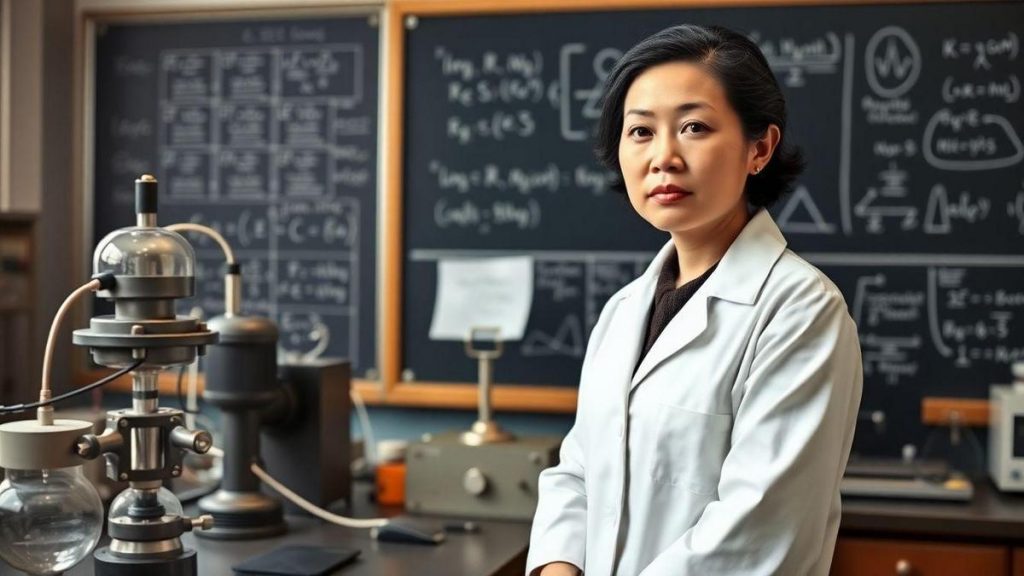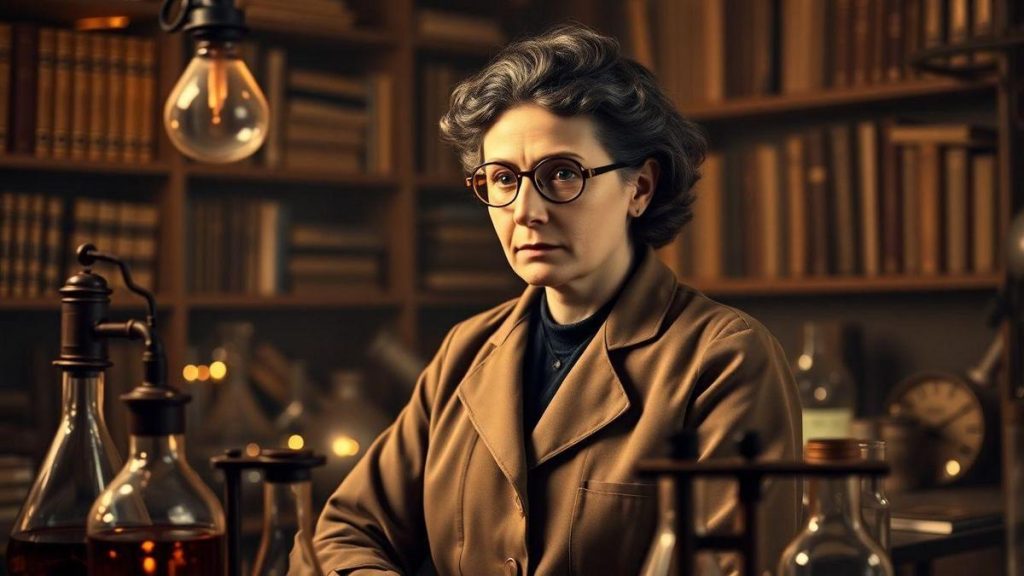Rosalind Franklin played a crucial role in the history of science, especially in the discovery of the structure of DNA. Her expertise in X-ray crystallography and her meticulous work directly contributed to the understanding of the famous double helix, one of the most important discoveries in molecular biology.
Despite the relevance of her contributions, Franklin did not receive the recognition she deserved during her lifetime. It was only after her death that the scientific community acknowledged the importance of her work, which helps to understand how the history of science can be affected by the dynamics of recognition and collaboration among researchers.
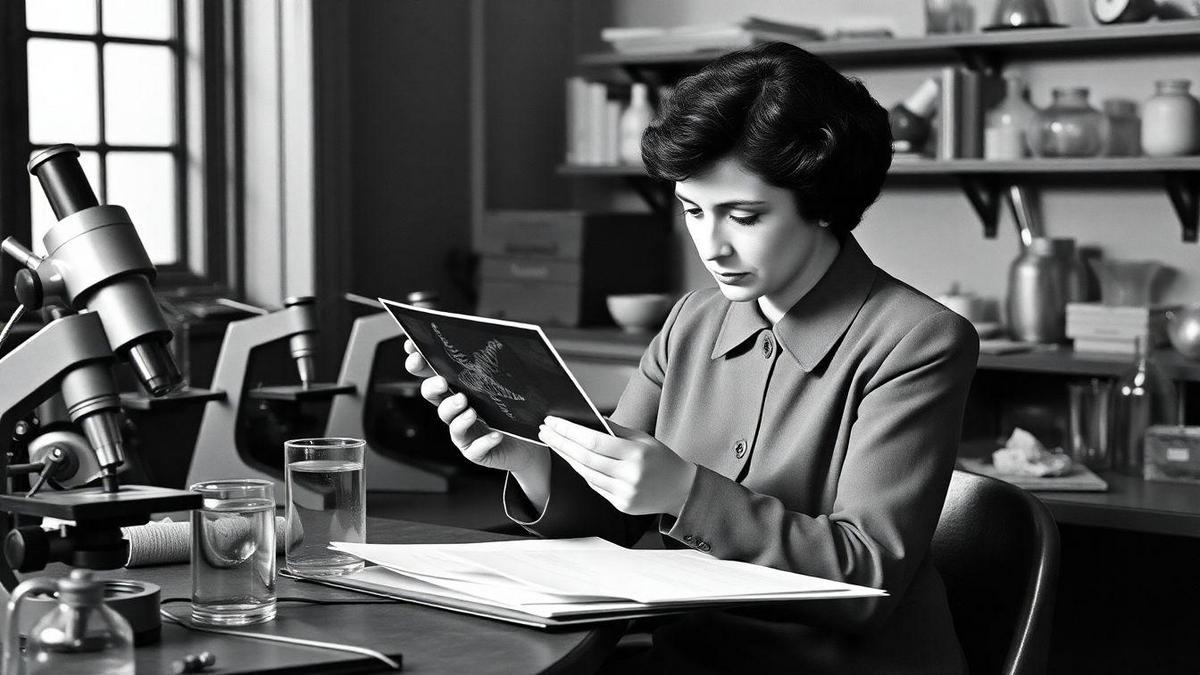
How X-ray Crystallography Techniques Work
X-ray crystallography is an essential tool for determining the structure of molecules and crystals. By directing X-rays at a sample, scientists can analyze the diffraction pattern and infer the position of atoms in the structure. Franklin applied this technique to study DNA, obtaining crucial images for her discovery.
At King’s College, Franklin refined X-ray crystallography techniques to obtain clear images of DNA. Her work culminated in the famous “Photograph 51,” which was key to understanding the helical structure of DNA. Her ability to create clear and precise images was vital for scientific progress.
To obtain such detailed images, Franklin had to ensure that the DNA samples were perfectly crystallized. This required careful preparation and a deep understanding of the materials. Her innovative methodologies significantly influenced the use of crystallography in molecular biology.
Although X-ray crystallography is a challenging technique, Franklin demonstrated mastery in interpreting the data obtained. Her work not only revealed the structure of DNA but also established new standards for using crystallography in other areas of science.
Advantages of Rosalind Franklin’s Contribution to the DNA Structure
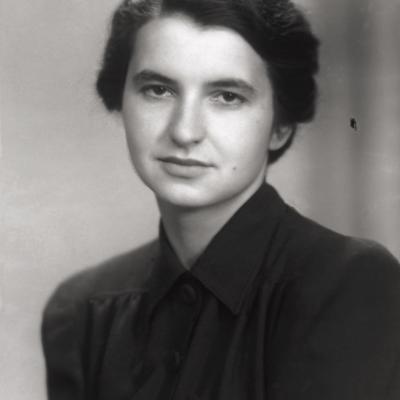
Franklin’s contribution was fundamental to revealing the structure of DNA. Her research provided the necessary images to identify the double helix, which was crucial for understanding genetics and molecular biology. Without her images, this discovery would have been delayed.
Moreover, her work demonstrated the value of X-ray crystallography in structural biology. Franklin not only helped reveal the structure of DNA but also showed how this technique could be applied to other biomolecules, leading to significant discoveries in medicine and pharmacology.
Franklin also served as a role model for women scientists, challenging the gender norms of her time. Her determination and scientific excellence continue to inspire generations of women aspiring to careers in science.
Franklin’s story also highlights the importance of ethics in science. Her delayed recognition shows how collaboration and the fair attribution of credit can impact the history of scientific discoveries and the careers of those involved.
How Rosalind Franklin Influenced the Discovery of the DNA Structure
Rosalind Franklin played a crucial role in the discovery of the DNA structure, especially through her X-ray crystallography images. Her contribution was essential to understanding the famous double helix of DNA, which revolutionized molecular biology.
“Photograph 51,” one of Franklin’s images, was decisive in allowing Watson and Crick to formulate the double helix model. Without Franklin’s precise images, constructing the correct model would have been impossible or much more time-consuming.
In addition to the images, Franklin also helped identify two distinct forms of DNA, which was crucial for the correct analysis of the diffraction data. Her discoveries enriched the interpretation of the results and made the proposed structure more solid.
Franklin’s work established a new standard for research in molecular biology, and her application of X-ray crystallography directly influenced the development of techniques used in other scientific research.
Posthumous Recognition of Rosalind Franklin
Although Rosalind Franklin’s work was crucial to the discovery of DNA, she did not receive the recognition she deserved during her lifetime. It was only after her death that science began to recognize the importance of her contributions to molecular biology.
Franklin’s story highlights how gender dynamics and the lack of fair attribution can obscure the true extent of someone’s work. This underscores the importance of properly valuing the contributions of all scientists, regardless of their gender or status in the scientific community.
The posthumous recognition of Franklin also highlights the relevance of transparent collaboration in the scientific field. Her story serves as a reminder that, for scientific advances to be fair and complete, the contributions of all involved must be recognized.
Today, Franklin is widely celebrated for her work. Her contribution has become an inspiration for future generations of scientists, especially women, who seek to pursue careers in science and overcome barriers similar to those she faced.
Introduction to Rosalind Franklin’s Contribution to the Discovery of DNA
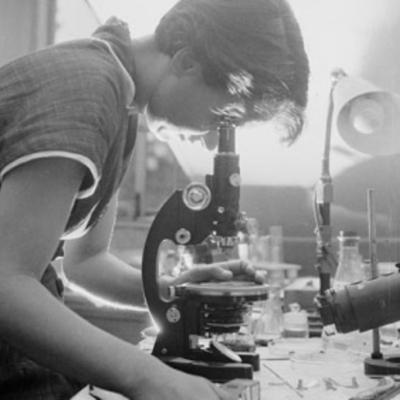
Rosalind Franklin is a key figure in the history of science, particularly in the discovery of the structure of DNA. Born in 1920 in London, Franklin was a chemist and crystallographer who made significant contributions to understanding the molecular structure of various substances, including DNA. Her research in X-ray crystallography was crucial in uncovering the famous double helix of DNA, a feat that revolutionized molecular biology and paved the way for significant advances in genetics and medicine.
Despite her invaluable contributions, Franklin did not receive due recognition in her time. Her work was often overshadowed by her male colleagues, and it was only after her death that her essential role in the discovery of DNA began to be widely acknowledged. This article explores the importance of Franklin’s work, highlighting how her X-ray crystallography techniques were key to understanding the structure of DNA and the advantages her contribution brought to science.
How X-ray Crystallography Techniques Work
X-ray crystallography is a powerful technique used to determine the atomic and molecular structure of a crystal. When an X-ray beam is directed at a crystal, the atoms within the crystal scatter the beam in several directions. From the resulting diffraction pattern, scientists can infer the position of the atoms within the structure. Rosalind Franklin used this technique to study DNA, allowing her to capture detailed images that were crucial in deciphering its structure.
Franklin worked at King’s College London, where her research focused on obtaining high-quality images of DNA through X-ray crystallography. She perfected the technique to the point where she was able to produce a now-famous image, known as “Photograph 51.” This image was crucial for identifying the double helical structure of DNA. The precision and clarity of the images Franklin obtained were possible due to her meticulous skill and deep understanding of the physical properties of X-rays and DNA samples.
The X-ray crystallography technique, as used by Franklin, involves the careful preparation of DNA samples, which must be crystalline to allow for clear diffraction of X-rays. Franklin developed methods to keep the DNA in conditions that preserved its natural structure, which was a critical step in obtaining accurate images. Her meticulous and innovative work established new standards for research in crystallography, influencing generations of scientists.
Although X-ray crystallography is a complex technique that requires a high level of precision and skill, Franklin demonstrated remarkable ability in manipulating and interpreting the data obtained. Her work not only contributed to the discovery of DNA but also set a precedent for the use of X-ray crystallography in other areas of science, including determining the structures of proteins and other biomolecules.
Advantages of Rosalind Franklin’s Contribution to the DNA Structure
Rosalind Franklin’s contribution to the discovery of the DNA structure brought numerous advantages to the field of molecular biology and beyond. First, her research was essential to understanding the double helical structure of DNA, which is crucial for replication and genetic transmission. Without her detailed images, the precise identification of the DNA structure would have been significantly delayed, impacting subsequent scientific progress.
Moreover, Franklin’s work helped establish the importance of X-ray crystallography as an essential tool in structural biology. Her ability to produce high-quality images allowed other scientists to apply the technique to explore the structure of other biomolecules, leading to discoveries with implications in medicine, pharmacology, and biotechnology. The accuracy of her techniques continues to serve as a benchmark for modern research.
Another important aspect of Franklin’s contribution was the inspiration she provided to women in science. Despite facing gender discrimination in her career, Franklin persevered and left a lasting legacy. Her work and determination continue to inspire generations of scientists, especially women, to pursue careers in science and challenge established gender norms. Her story is a testament to the impact that unwavering dedication to science can have, regardless of the barriers faced.
Finally, Franklin’s contribution to science also highlights the importance of collaboration and ethics in scientific research. Although her work was initially underestimated and appropriated by other scientists, the posthumous recognition of her contribution underscores the need for fair and accurate attribution in the scientific field. Franklin’s story serves as a reminder of the importance of valuing and acknowledging the work of all researchers involved in scientific discoveries.
Did You Enjoy Learning About Rosalind Franklin’s Contribution to the DNA Structure?
Learning about Rosalind Franklin’s contribution to the DNA structure is diving into a fascinating chapter in the history of science. Her research not only revolutionized our understanding of genetics but also highlighted the importance of precision and ethics in science. Franklin’s story is a powerful reminder of the lasting impact that a dedicated scientist can have.
We hope this article has sparked your interest in the history of science and Rosalind Franklin’s incredible contribution. Her life and work continue to inspire scientists worldwide, and her story is a testament to the power of determination and scientific innovation. Explore more on this topic and discover how science continues to evolve thanks to pioneers like Franklin.
Frequently Asked Questions
What did Rosalind Franklin discover?
Rosalind Franklin was crucial in revealing the structure of DNA through her famous X-ray images, known as Photograph 51.
How did Photograph 51 help discover the structure of DNA?
Rosalind Franklin’s Photograph 51 showed the double helix pattern of DNA, allowing other scientists to understand its shape.
Why is Rosalind Franklin’s contribution important?
Rosalind Franklin’s contribution was essential for understanding the structure of DNA, changing the course of modern biology.
Did Rosalind Franklin receive recognition for her work?
Unfortunately, during her lifetime, Rosalind Franklin’s work did not receive the recognition it deserved; however, she is now widely recognized for her crucial role in the study of DNA.
How did Rosalind Franklin influence science today?
Rosalind Franklin and her crucial role in discovering the DNA structure paved the way for advances in genetics and biomedicine, impacting science to this day.

